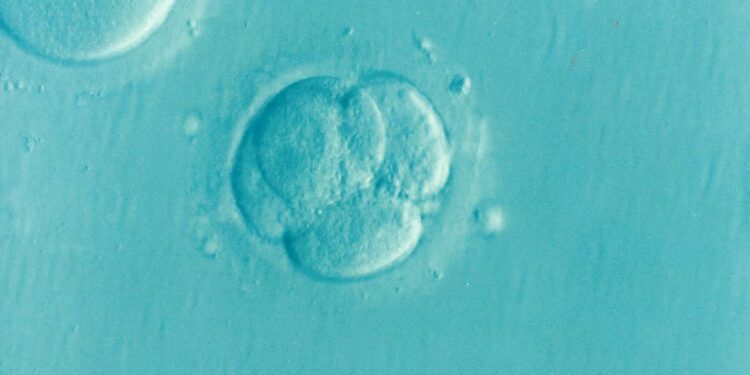Credit: Pixabay/CC0 Public domain
All animals evolved because certain viruses infected primitive organisms hundreds of millions of years ago. Viral genetic material was integrated into the genome of the first multicellular beings and is still present in our DNA today.
For the first time, researchers from the CNIO (Spanish National Cancer Research Center) describe in the journal Scientists progress the role played by these viruses in a process absolutely vital for our development, and which occurs a few hours after fertilization: the transition to pluripotency, when the oocyte goes from two to four cells.
Before this stage, each of the two cells of the embryo is totipotent, that is to say that it can develop inside an independent organism; the four cells in the next stage are not totipotent but pluripotent, because they can differentiate into cells of any specialized tissue in the body.
For Sergio de la Rosa and Nabil Djouder, first and senior author respectively, this discovery is relevant for the field of regenerative medicine and for the creation of artificial embryos, because it opens a new way to generate stable cell lines in phases of totipotency. . Djouder heads the Growth Factors, Nutrients and Cancer group at the CNIO.
We are at 8% retroviruses
Genetic material from “endogenous retroviruses” has been integrated into the genomes of organisms that may have caused the Cambrian Explosion, a period more than 500 million years ago during which the seas of the world have experienced a “boom” in biodiversity. Over the past decade, it has been found that the genetic sequences of these viruses constitute at least 8-10% of the human genome.
“Until recently, these viral remains were considered ‘junk DNA,’ unusable or even harmful genetic material,” says De la Rosa. “Intuitively, it was thought that having viruses in the genome could not be a good thing. However, in recent years we are starting to realize that these retroviruses, which have co-evolved with us for millions of years, have important functions, such as the regulation of other genes. This is an extremely active area of research.
The transition from totipotency to pluripotency, a question of rhythm
Research shows that the endogenous retrovirus MERVL sets the tone for embryo development, particularly during the specific stage of transition from totipotency to pluripotency, and explains the mechanism that allows this to happen.
“This is a completely new role for endogenous retroviruses,” explains Djouder. “We discovered a new mechanism that explains how an endogenous retrovirus directly controls pluripotency factors.”
This new mechanism of action involves URI, a gene that Djouder’s group is studying in depth. Years ago, it was discovered that if the URI was deleted in laboratory animals, the embryos could not even develop. De la Rosa wanted to know why and how its link to the MERVL retrovirus was discovered.
A smooth transition
The results show that one of the functions of the URI is to allow the action of molecules essential for the acquisition of pluripotency; if the URI does not act, neither do the pluripotency factors, and the cell remains in a state of totipotency. This is an endogenous retrovirus protein, MERVL-gag, which modulates the action of the URI.
The researchers found that during the totipotency phase, when there are only two cells in the oocyte, expression of the viral protein MERVL-gag is high; this protein binds to the URI and prevents it from acting. However, the levels gradually change, so that the levels of viral protein MERVL-gag decrease and the URI can kick in: pluripotency appears.
As De la Rosa explains: “It’s a smooth transition. When there is high viral protein expression, there are fewer pluripotency factors; as ERV expression decreases, URI stabilizes these factors. »
Symbiotic coevolution
“Our results reveal a symbiotic coevolution of endogenous retroviruses with their host cells to ensure the smooth and rapid progression of early embryonic development,” the authors explain.
In other words, the three-way relationship between the viral protein, the URI and the pluripotency factors is finely modulated, “to allow sufficient time for the embryo to adjust and coordinate the smooth transition of the totipotency to pluripotency and cell lineage specification during embryonic development.” concludes Djouder.
More information:
Sergio de la Rosa et al, Endogenous retroviruses shape the specification of pluripotency in mouse embryos, Scientists progress (2024). DOI: 10.1126/sciadv.adk9394. www.science.org/doi/10.1126/sciadv.adk9394
Provided by the Spanish National Cancer Research Center
Quote: A virus that infected animals hundreds of millions of years ago has become essential for the development of the embryo (January 24, 2024) retrieved January 24, 2024 from
This document is subject to copyright. Apart from fair use for private study or research purposes, no part may be reproduced without written permission. The content is provided for information only.



